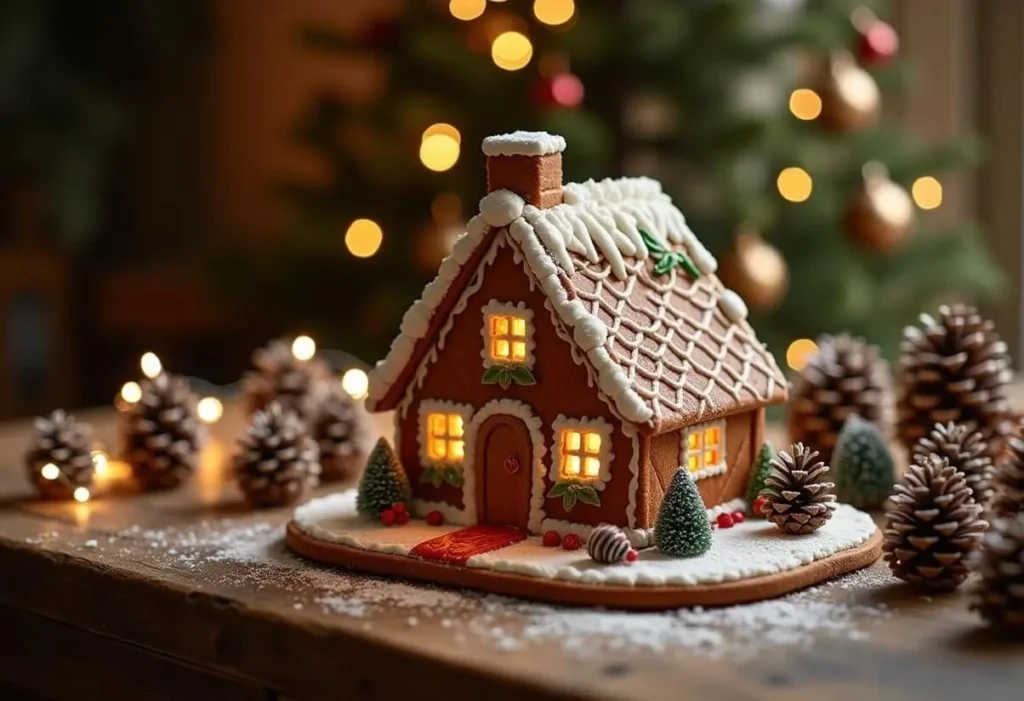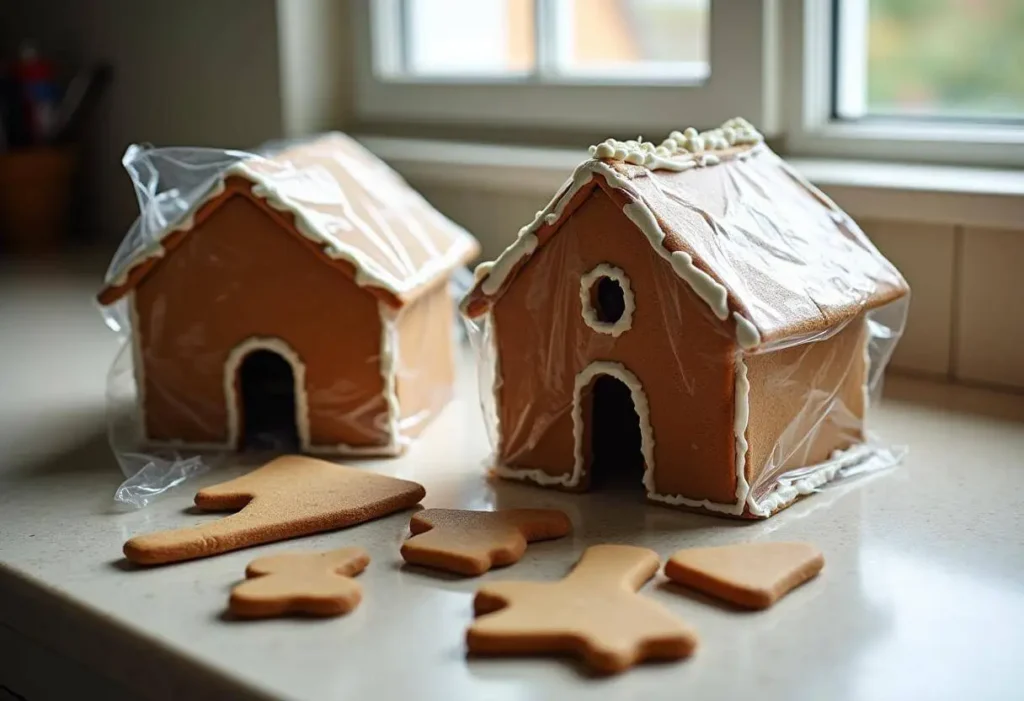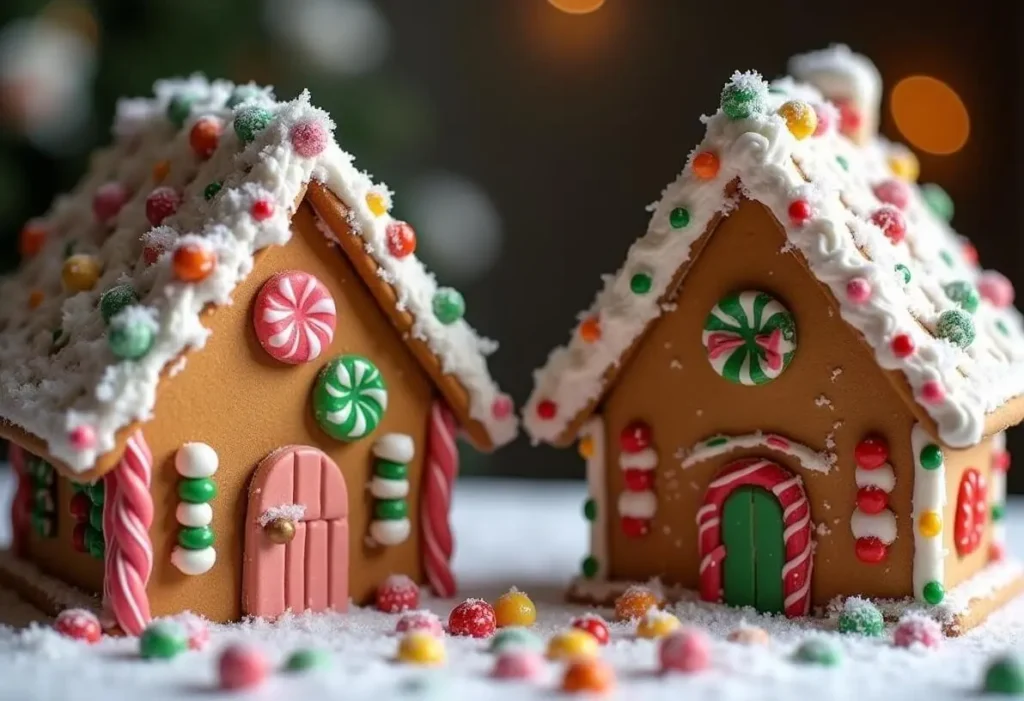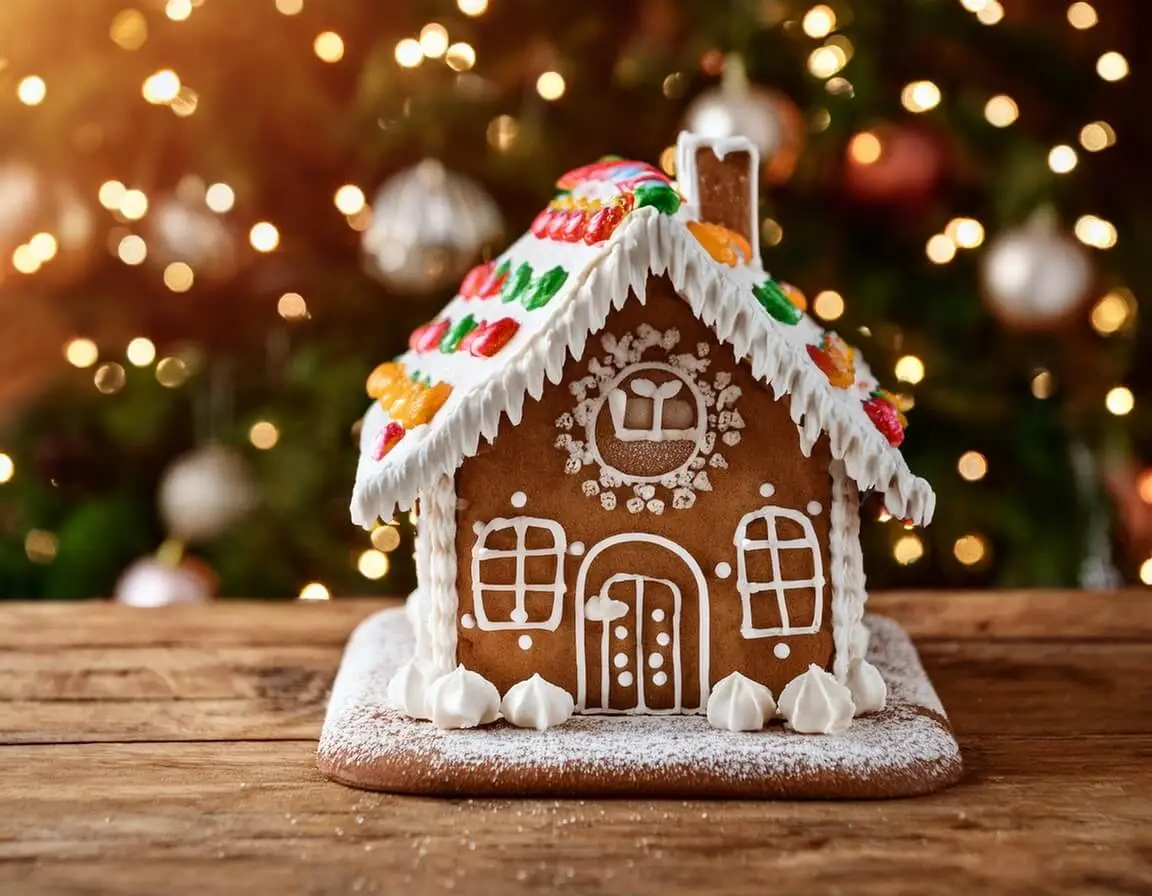Introduction
The holiday season brings with it the joy of creating gingerbread houses, a delightful mix of edible artistry and family fun. While these festive creations are often admired for their intricate designs, one important question often arises: What is the expiration date on gingerbread houses in the USA? Whether you’re baking one from scratch or assembling a store-bought kit, understanding their shelf life ensures you can enjoy them safely and at their freshest.
This guide dives into the factors that influence how long a gingerbread house lasts, including whether it’s intended as a decorative centerpiece or an edible treat. We’ll explore essential storage tips to maximize their longevity, how to recognize when a gingerbread house has expired, and the differences in lifespan between homemade and store-bought options.

Knowing these details is particularly important if you plan to eat your gingerbread house or keep it on display for an extended period. With proper care and storage, you can prolong the freshness and beauty of your holiday creation, making it a cherished part of the season. Let’s uncover the secrets to maintaining your gingerbread masterpiece!
1. Understanding the Expiration Date on Gingerbread Houses
What Is the Expiration Date on Gingerbread Houses in the USA?
The expiration date on gingerbread houses in the USA depends on whether they are homemade or store-bought, as well as their intended purpose—edible or decorative. For homemade gingerbread houses, freshness is key, and they are typically safe to eat for 2–3 weeks if stored properly in a cool, dry place. On the other hand, store-bought gingerbread house kits often have a longer shelf life due to preservatives. Unopened kits can last up to 12 months, but once assembled, their edibility window shortens to about 1–2 weeks.
A key distinction lies in whether the gingerbread house is meant to be eaten or simply displayed. Edible houses are crafted with freshness in mind, while decorative houses are often made with durability as a priority, which may involve non-food-safe adhesives or sealants.
Does a Gingerbread House Expire?
Yes, gingerbread houses do expire, especially if they’re edible. Several factors contribute to this process:
- Ingredient Degradation: Over time, the gingerbread base becomes stale and loses its crispness, while royal icing may crack or soften.
- Exposure to Air: Once assembled, the gingerbread house is exposed to air, leading to gradual drying or, in humid environments, absorption of moisture.
- Candy Decorations: Candies may harden or lose flavor, while chocolate elements can develop a white bloom, indicating a loss of quality.
For example, a homemade gingerbread house stored without proper sealing may feel rock-hard and lose its flavor within a week, whereas a decorative store-bought gingerbread house can remain visually intact for months but won’t taste fresh. Understanding these differences ensures you can plan appropriately for your holiday treat or display.
2. Factors Affecting Gingerbread House Longevity
Ingredients and Their Shelf Life
The longevity of a gingerbread house begins with the ingredients used.
- Gingerbread Dough: Freshly baked gingerbread has a shelf life of 2–3 weeks if stored in an airtight container. When left exposed, it hardens quickly and may become too brittle to enjoy. Recipes with a higher sugar content tend to last longer as sugar acts as a preservative.
- Royal Icing: Often made from egg whites or meringue powder, royal icing dries hard and serves as the glue for assembling the house. While durable, it is prone to cracking over time, especially in humid conditions.
- Candy Decorations: The shelf life of candies varies—hard candies and gumdrops can last months, while chocolates may degrade faster, developing a powdery white bloom when exposed to moisture or fluctuating temperatures.

Using a high-quality gingerbread house recipe can ensure a sturdier and longer-lasting structure, particularly if you aim to use it as a decoration.
Storage Conditions
Proper storage is crucial for maximizing the lifespan of a gingerbread house.
- Humidity: High humidity causes gingerbread to absorb moisture, leading to softening and eventual collapse.
- Temperature: Warm temperatures accelerate staling, while cooler, dry environments help preserve freshness.
- Airtight Wrapping: Wrapping the gingerbread house in plastic wrap or storing it in a sealed container slows down air exposure and maintains freshness for longer.
Actionable Tips:
- Place the gingerbread house in a room with controlled humidity.
- Avoid placing it near windows or heating vents.
- For edible houses, use cling film or foil to keep the structure intact.
To understand more about how humidity affects baked goods, this guide from baking experts provides helpful details.
Edibility vs. Decoration
The intended use of a gingerbread house greatly affects its lifespan.
- Edible Houses: Made to be consumed, these should be eaten within 1–2 weeks to enjoy peak flavor and texture.
- Decorative Houses: Built with durability in mind, decorative gingerbread houses can last for 4 weeks or more, especially if treated with a food-safe spray or varnish. However, they are often not safe for consumption due to potential use of non-edible adhesives.
How Long Can a Gingerbread House Sit Out For?
A gingerbread house can sit out for up to 4 weeks as a decoration. However, edible versions should not sit out for more than 1–2 weeks, as they lose freshness and may harbor bacteria. For long-term displays, decorative gingerbread houses should be kept away from sunlight and wrapped to prevent dust accumulation.
3. Extending the Shelf Life of Gingerbread Houses
Tips for Storing Gingerbread Houses
Proper storage is essential to keeping your gingerbread house fresh and visually appealing for as long as possible.
- Use Airtight Containers: Place your assembled gingerbread house in a large, airtight container to shield it from air exposure and moisture. This helps retain freshness for edible houses and prevents decorative houses from becoming brittle or soggy.
- Wrap in Plastic: If a container is unavailable, tightly wrap the house in plastic wrap. Focus on sealing gaps around the base and edges to minimize air contact.
- Cool and Dry Storage: Store the house in a room with low humidity and temperatures below 70°F to slow the staling process.
Step-by-Step Storage Instructions:
- Gently remove any loose or fragile decorations.
- Wrap the house securely in plastic wrap or place it in an airtight container.
- Store the container or wrapped house in a cool, dry location, away from direct sunlight or heat sources.
- For edible houses, check freshness periodically and consume within the recommended timeframe.
Protecting Against Moisture
Humidity is the biggest enemy of gingerbread houses. Even a small amount of moisture can cause structural damage or degrade edible components. Here are some effective strategies to guard against moisture:
- Food-Safe Sealants: For decorative houses, spray the gingerbread with a food-safe sealant to create a moisture barrier.
- Silica Gel Packs: Place food-safe silica gel packs inside the storage container to absorb any excess moisture. Ensure they do not touch edible components directly.
- Dehumidifiers: Use a dehumidifier in the storage area to maintain optimal humidity levels.
Freezing Gingerbread for Long-Term Use
Freezing is a great way to preserve gingerbread houses or their components for months.
- Disassemble for Best Results: Carefully separate the pieces to prevent damage during freezing. If disassembly isn’t possible, ensure the entire house is well-wrapped.
- Wrap Each Piece: Wrap each piece of gingerbread in plastic wrap, followed by aluminum foil, to prevent freezer burn.
- Store in Freezer-Safe Bags: Place the wrapped pieces in a labeled freezer-safe bag and store them flat to avoid breaking.

Thawing Instructions:
- Remove the pieces from the freezer and let them thaw at room temperature for 2–3 hours.
- Avoid unwrapping until fully thawed to prevent condensation from forming on the gingerbread.
- Reassemble the house using fresh icing for a renewed look and flavor.
For additional tips on safe methods for freezing baked goods, refer to this trusted resource.
4. Identifying When a Gingerbread House Has Expired
Signs of Expired Gingerbread Houses
Recognizing when a gingerbread house has expired is crucial, especially if you plan to eat it. Here are the key indicators to watch for:
- Stale or Brittle Texture: Fresh gingerbread has a firm yet slightly soft texture. As it ages, it becomes excessively dry and brittle, making it unpleasant to eat.
- Mold or Discoloration: Visible mold or dark spots on the gingerbread or icing are clear signs that the house is no longer safe for consumption. This typically occurs when moisture has seeped into the structure.
- Off Smells: A sour or musty odor often indicates that the gingerbread or its decorations have spoiled, signaling it’s time to discard.
These sensory checks can help determine whether your gingerbread house is still fresh enough to eat or display.
When to Discard
It’s important to know when to let go of your gingerbread house to avoid potential health risks. Here are some guidelines:
- Mold or Moisture Damage: If you notice any signs of mold or excessive softening due to moisture, the gingerbread house should be discarded immediately, as these conditions can lead to harmful bacteria.
- Excessive Staleness: While a stale house may still be edible, its taste and texture will likely be unappealing. For the best experience, consume or replace it before it becomes rock-hard.
- Long-Term Display: Decorative houses can often sit out for weeks without issues. However, if dust accumulation or fading becomes evident, it’s better to retire the house as a display piece.
Tip: For decorative gingerbread houses, consider photographing your masterpiece before discarding it to preserve the memory of your hard work.
5. Gingerbread House Kits and Their Shelf Life
Shelf Life of Gingerbread House Kits
Gingerbread house kits are a convenient option for those who want to enjoy the holiday tradition without the hassle of baking from scratch. Unopened kits typically have a long shelf life of up to a year, thanks to preservatives in the gingerbread and icing mixes. However, this shelf life is contingent on storing the kit in a cool, dry place away from direct sunlight or moisture.
Once the kit is assembled, its longevity changes significantly. An assembled gingerbread house, whether made from a kit or baked at home, is best consumed within 1–2 weeks to ensure the freshness of the gingerbread and the icing. After this period, the house may still look intact for decorative purposes, but its edibility diminishes.
Do Gingerbread Cookies Expire?
Gingerbread cookies, like the components of a gingerbread house, do expire, though they generally last longer when stored properly. Standalone gingerbread cookies remain fresh for 2–3 weeks at room temperature if kept in an airtight container. Freezing extends their lifespan to 2–3 months, making them a great make-ahead option for the holiday season.
The main factors that cause gingerbread cookies to expire are:
- Exposure to Air: This leads to hardening and loss of flavor.
- Humidity: Moist environments can make cookies soggy or promote mold growth.
Whether part of a gingerbread house or enjoyed as individual treats, gingerbread cookies require proper storage to maximize their shelf life. Use similar storage techniques as you would for a gingerbread house, such as airtight containers or freezing, to keep them fresh.
6. Related Expiration Concerns
How Long Does a Gingerbread Man Last?
Gingerbread men are a cherished holiday treat, but their longevity can vary depending on how they are stored. Proper storage in an airtight container can help maintain their freshness, while freezing is a great way to extend their shelf life. However, factors such as exposure to air, humidity, and ingredient quality all play a role in how long these cookies last.
If you’re curious about the exact timeline and want detailed tips on how to keep your gingerbread men fresh, check out this guide on how long a gingerbread man lasts for more insights. This comprehensive resource explores everything you need to know about maximizing their lifespan.
For decorative gingerbread men, longevity might differ since they’re not typically intended for consumption, but proper care can help them last longer as festive displays.
Edibility of Decorations
Decorations play a key role in the appeal of a gingerbread house or gingerbread men, but their freshness doesn’t last indefinitely.
- Candy Decorations: Hard candies, gumdrops, and candy canes are often used, and while they can last for months, they lose their flavor and texture over time. Prolonged exposure to air can cause them to harden excessively or become sticky, especially in humid environments.
- Icing: Royal icing dries hard, which makes it an effective glue for construction. However, it is prone to cracking over time, especially if the gingerbread house is exposed to temperature fluctuations or moisture.
- Chocolate Elements: Chocolates used in decoration may develop a white powdery layer (called bloom) due to fat separation, signaling they are no longer fresh.

While decorative components may still look attractive for weeks or months, they should not be eaten once they show signs of degradation, as their quality and safety may be compromised.
To learn more about food-safe decorating materials, visit this educational page by the Food and Drug Administration.
7. FAQ Section: Common Questions About Gingerbread Expiration
How Long Are Gingerbread Houses Edible For?
Gingerbread houses are typically edible for 1–2 weeks after assembly, provided they are stored properly in a cool, dry environment. Homemade gingerbread houses, crafted with fresh ingredients, tend to have a shorter shelf life compared to store-bought kits, which may include preservatives. To maximize freshness, wrap the house in plastic or store it in an airtight container.
While decorative gingerbread houses may still look intact for weeks, their edibility diminishes rapidly due to exposure to air, moisture, and environmental dust. For the best taste and texture, it’s recommended to consume them within the suggested timeframe.
Can You Eat a Decorative Gingerbread House?
Decorative gingerbread houses are not always intended for consumption. Many use non-food-safe materials like adhesive glue, spray sealants, or inedible decorative elements to maintain their appearance. If the house has been on display for an extended period, it may also collect dust or other contaminants, making it unsafe to eat.
If you’re considering eating a decorative gingerbread house, assess its condition first. Avoid eating houses with cracked icing, mold, or candies that have hardened excessively. For safety, it’s best to enjoy gingerbread houses meant for eating, and keep decorative ones as beautiful centerpieces.
8. Conclusion: Maximizing the Life of Your Gingerbread House
Understanding what is the expiration date on gingerbread houses in the USA helps you enjoy these festive creations to the fullest. Whether you’re indulging in an edible masterpiece or showcasing a decorative centerpiece, proper care ensures your gingerbread house remains fresh and appealing for its intended purpose.
To recap, edible gingerbread houses should be consumed within 1–2 weeks to enjoy the best flavor and texture. Store them in cool, dry conditions and protect them from air and humidity by using airtight containers or plastic wrap. For longer-term preservation, freezing disassembled gingerbread pieces is an effective option.
Decorative gingerbread houses, on the other hand, can last for up to 4 weeks or longer as visual displays. To maintain their appearance, keep them away from moisture, direct sunlight, and dust. Using food-safe sprays or silica gel packs can help preserve their structure for an extended period.
With these tips in mind, you can prolong the life of your gingerbread house and enjoy the holiday tradition without worries. Whether you’re eating or displaying, make the most of this seasonal delight and create lasting memories!

